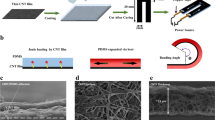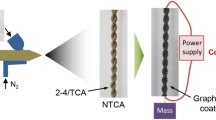Abstract
Electrothermal actuators (ETAs) are intelligent devices that can produce various movements from thermal expansion induced by Joule heating. In this work, to build a low normalized voltage-driven and low-working-temperature ETA, reduced graphene oxide (rGO) paper with high electrothermal performance and flexibility was adopted as the electrothermal-active materials. The high electrothermal performance of the prepared rGO-60 papers was demonstrated as that a steady-state temperature of 306.1 °C was achieved at a normalized voltage of 2.67 V. Then a bilayer-structured ETA based on rGO-60 and polyethylene (PE) was developed in a simple and mass production possible process. Under a normalized driving voltage of 0.449 V, the prepared rGO-60/PE ETA showed a bending curvature of 2.22 cm−1 at a working temperature of 43.8 °C. Finally, a simple robotic finger prepared by using a single rGO-60/PE ETA was demonstrated to hook the spitball, which is more than 16 times the weight itself. With the advantages of its low-voltage driving, low working temperature and easy to manufacture, the rGO/PE-based electrothermal actuators have a promising application in soft robotics and intelligent systems.






Similar content being viewed by others
Data availability
The datasets generated during and/or analyzed during the current study are available from the corresponding author on reasonable request.
References
Y. Zhang, J. Li, H. Zhou et al., Electro-responsive actuators based on graphene. Innovation 2, 100168 (2021). https://doi.org/10.1016/j.xinn.2021.100168
E. Acome, S.K. Mitchell, T.G. Morrissey et al., Hydraulically amplified self-healing electrostatic actuators with muscle-like performance. Science 359, 61–65 (2018). https://doi.org/10.1126/science.aao6139
H. Arazoe, D. Miyajima, K. Akaike et al., An autonomous actuator driven by fluctuations in ambient humidity. Nat. Mater. 15, 1084–1089 (2016). https://doi.org/10.1038/nmat4693
X. Ji, X. Liu, V. Cacucciolo et al., An autonomous untethered fast soft robotic insect driven by low-voltage dielectric elastomer actuators. Sci. Robot. 4, eaaz6451 (2019). https://doi.org/10.1126/scirobotics.aaz6451
C. Zhao, H. Zhang, C. Song et al., Mechanisms of plant responses and adaptation to soil salinity. Innovation 1, 1–41 (2020). https://doi.org/10.1016/j.xinn.2020.100017
M. Ilami, H. Bagheri, R. Ahmed et al., Materials, actuators, and sensors for soft bioinspired robots. Adv. Mater. 33, 2003139 (2020). https://doi.org/10.1002/adma.202003139
J. Liang, L. Huang, N. Li et al., Electromechanical actuator with controllable motion, fast response rate, and high-frequency resonance based on graphene and polydiacetylene. ACS Nano 6, 4508–4519 (2012). https://doi.org/10.1021/nn3006812
H. Kim, H. Lee, I. Ha et al., Biomimetic color changing anisotropic soft actuators with integrated metal nanowire percolation network transparent heaters for soft robotics. Adv. Funct. Mater. 28, 1801841–1801847 (2018)
Y. Hu, G. Wu, T. Lan et al., A graphene-based bimorph structure for design of high performance photoactuators. Adv. Mater. 27, 7867–7873 (2015). https://doi.org/10.1002/adma.201502777
J. Wang, D. Gao, P.S. Lee, Recent progress in artificial muscles for interactive soft robotics. Adv. Mater. 33, 2003088 (2021). https://doi.org/10.1002/adma.202003088
D. Jia, W.J. Yuan, Research progress in electromechanical artificial muscles. Polym. Bull. 8, 27–38 (2017). https://doi.org/10.14028/j.cnki.1003-3726.2017.08.004
R. Pelrine, R. Kornbluh, G. Kofod, High-strain actuator materials based on dielectric elastomers. Adv. Mater. 12, 1223–1225 (2000). https://doi.org/10.1002/1521-4095(200008)12:16%3c1223::AID-ADMA1223%3e3.0.CO;2-2
R.S. Diteesawat, T. Helps, M. Taghavi et al., Electro-pneumatic pumps for soft robotics. Sci. Robot. 6, eabc3721 (2021). https://doi.org/10.1126/scirobotics.abc3721
B. Kim, Y.D. Park, K. Min et al., Electric actuation of nanostructured thermoplastic elastomer gels with ultralarge electrostriction coefficients. Adv. Funct. Mater. 21, 3242–3249 (2011). https://doi.org/10.1002/adfm.201100298
R. Pelrine, R. Kornbluh, Q. Pei et al., High-speed electrically actuated elastomers with strain greater than 100%. Science 287, 836–839 (2000). https://doi.org/10.1126/science.287.5454.836
T.Y. Zhang, Q. Wang, N.Q. Deng et al., A large-strain, fast-response, and easy-to-manufacture electrothermal actuator based on laser-reduced graphene oxide. Appl. Phys. Lett. 111, 121901 (2017). https://doi.org/10.1063/1.5003610
Y. Huang, W. Hu et al., A low-voltage graphene/Ag-based phase transition-controlled force actuator. Compos. B Eng. 174, 106912 (2019). https://doi.org/10.1016/j.compositesb.2019.106912
Y.C. Sun, B.D. Leaker, J.E. Lee et al., Shape programming of polymeric based electrothermal actuator (ETA) via artificially induced stress relaxation. Sci. Rep. 9, 1–12 (2019). https://doi.org/10.1038/s41598-019-47949-0
D.K. Seo, T.J. Kang, D.W. Kim et al., Twistable and bendable actuator: a CNT/polymer sandwich structure driven by thermal gradient. Nanotechnology 23, 75501 (2012). https://doi.org/10.1088/0957-4484/23/7/075501
L. Chen, C. Liu, K. Liu et al., High-performance, low-voltage, and easy-operable bending actuator based on aligned carbon nanotube/polymer composites. ACS Nano 5, 1588–1593 (2011). https://doi.org/10.1021/nn102251a
Q. Li, C. Liu, Y.H. Lin et al., Large-strain, multiform movements from designable electrothermal actuators based on large highly anisotropic carbon nanotube sheets. ACS Nano 9, 409–418 (2015). https://doi.org/10.1021/nn505535k
Y. Hu, T. Lan, G. Wu et al., Novel electromechanical actuation based on a spongy graphene paper. Chem. Commun. 50, 4951–4954 (2014). https://doi.org/10.1039/c3cc49376h
M.A. Aouraghe, F. Xu, X. Liu et al., Flexible, quickly responsive and highly efficient E-heating carbon nanotube film. Compos. Sci. Technol. 183, 107824 (2019). https://doi.org/10.1016/j.compscitech.2019.107824
L. Zhu, Y.Y. Gao, B. Han et al., Laser fabrication of graphene-based electrothermal actuators enabling predicable deformation. Opt. Lett. 44, 1363 (2019). https://doi.org/10.1364/OL.44.001363
Q. Wang, Y. Li, T. Zhang et al., Low-voltage, large-strain soft electrothermal actuators based on laser-reduced graphene oxide/Ag particle composites. Appl. Phys. Lett. 112, 133902 (2018). https://doi.org/10.1063/1.5020918
N.I. Kovtyukhova, P.J. Ollivier, B.R. Martin et al., Layer-by-layer assembly of ultrathin composite films from micron-sized graphite oxide sheets and polycations. Chem. Mater. 11, 771–778 (1999). https://doi.org/10.1021/cm981085u
L. Dong, C. Hu et al., A large-area, flexible, and flame-retardant graphene paper. Adv. Funct. Mater. 26, 1470–1476 (2016). https://doi.org/10.1002/adfm.201504470
L. Sheng, Y. Liang, L. Jiang et al., Bubble-decorated honeycomb-like graphene film as ultrahigh sensitivity pressure sensors. Adv. Funct. Mater. 25, 6545–6551 (2015). https://doi.org/10.1002/adfm.201502960
H.Q. Li, L. Chen, P.F. Jin et al., NiCo2S4 microspheres grown on N, S co-doped reduced graphene oxide as an efficient bifunctional electrocatalyst for overall water splitting in alkaline and neutral pH. Nano Res. 15, 950–958 (2022). https://doi.org/10.1007/s12274-021-3580-z
J.X. Pang, H.H. Fu, W.W. Kong et al., Design of NiCo2O4 nanoparticles decorated N, S co-doped reduced graphene oxide composites for electrochemical simultaneous detection of trace multiple heavy metal ions and hydrogen evolution reaction. Chem. Eng. J. 433, 133854 (2022). https://doi.org/10.1016/j.cej.2021.133854
H. Tian, H. Chen, T. Ren et al., Cost-effective, transfer-free, flexible resistive random access memory using laser-scribed reduced graphene oxide patterning technology. Nano Lett. 14, 3214–3219 (2014). https://doi.org/10.1021/nl5005916
Y.G. Jeong, G.W. Jeon, Microstructure and performance of multiwalled carbon nanotube/m-aramid composite films as electric heating elements. ACS Appl. Mater. Interfaces 5, 6527–6534 (2013). https://doi.org/10.1021/am400892k
C. Celle, C. Mayousse, E. Moreau et al., Highly flexible transparent film heaters based on random networks of silver nanowires. Nano Res. 5, 427–433 (2012). https://doi.org/10.1007/s12274-012-0225-2
D. Sui, Y. Huang, L. Huang et al., Flexible and transparent electrothermal film heaters based on graphene materials. Small 7, 3186–3192 (2011). https://doi.org/10.1002/smll.201101305
T. Kim, Y.W. Kim, H.S. Lee et al., Uniformly interconnected silver-nanowire networks for transparent film heaters. Adv. Funct. Mater. 23, 1250–1255 (2013). https://doi.org/10.1002/adfm.201202013
Y.H. Yoon, J.W. Song, D. Kim et al., Transparent film heater using single-walled carbon nanotubes. Adv. Mater. 19, 4284–4287 (2007). https://doi.org/10.1002/adma.200701173
T. Zhang, H. Zhao, D. Wang et al., A super flexible and custom-shaped graphene heater. Nanoscale 9, 14357–14363 (2017). https://doi.org/10.1039/c7nr02219k
L.R. Shobin, S. Manivannan, Enhancement of electrothermal performance in single-walled carbon nanotube transparent heaters by room temperature post treatment. Sol. Energy Mater. Sol. Cells 174, 469–477 (2018). https://doi.org/10.1016/j.solmat.2017.09.041
F. Wang, K. Zhang, W. Liang et al., Experimental and analytical studies on the flexible, low-voltage electrothermal film based on the multi-walled carbon nanotube/polymer nanocomposite. Nanotechnology 30, 65704 (2018). https://doi.org/10.1088/1361-6528/aaf195
J. Luo, H. Lu, Q. Zhang et al., Flexible carbon nanotube/polyurethane electrothermal films. Carbon 110, 343–349 (2016). https://doi.org/10.1016/j.carbon.2016.09.016
X. Zhang, D. Li, K. Liu et al., Flexible graphene-coated carbon fiber veil/polydimethylsiloxane mats as electrothermal materials with rapid responsiveness. Int. J. Lightweight Mater. Manuf. 2, 241–249 (2019). https://doi.org/10.1016/j.ijlmm.2019.04.002
K. Shin, J. Hong, S. Lee et al., High electrothermal performance of expanded graphite nanoplatelet-based patch heater. J. Mater. Chem. 22, 23404–23410 (2012). https://doi.org/10.1039/C2JM34196D
S. Lin, T. Zhang, Q. Lu et al., High-performance graphene-based flexible heater for wearable applications. RSC Adv. 7, 27001–27006 (2017). https://doi.org/10.1039/C7RA03181E
J. Kang, H. Kim, K.S. Kim et al., High-performance graphene-based transparent flexible heaters. Nano Lett. 11, 5154–5158 (2011). https://doi.org/10.1021/nl202311v
T. Zhang, H. Zhao, Z. Yang et al., Improved electrothermal performance of custom-shaped micro heater based on anisotropic laser-reduced graphene oxide. Appl. Phys. Lett. 109, 151905 (2016). https://doi.org/10.1063/1.4963861
H. Chang, Y. Jia, L. Xiao et al., Three dimensional cross-linked and flexible graphene composite paper with ultrafast electrothermal response at ultra-low voltage. Carbon 154, 150–155 (2019). https://doi.org/10.1016/j.carbon.2019.08.008
Y. Guo, C. Dun, J. Xu et al., Ultrathin, washable, and large-area graphene papers for personal thermal management. Small 13, 1702645 (2017). https://doi.org/10.1002/smll.201702645
Y. Zhou, H. Bi, X. Xie, et al., Fabrication of graphene based electrothermal cantilever actuator, The 8th Annual IEEE International Conference on Nano/Micro Engineered and Molecular Systems, pp. 911–914 (2013). https://doi.org/10.1109/NEMS.2013.6559871
Funding
This work was supported by the National Natural Science Foundation of China (61774084), the Priority Academic Program Development of Jiangsu Higher Education Institutions, the special fund of Jiangsu Province for the transformation of scientific and technological achievements (BA2021093), the open project of Key Laboratory of Materials Preparation and Protection for Harsh Environment, Ministry of Industry and Information Technology (XCA20013-3), and funding of Jiangsu Innovation Program for Graduate Education (KYCX19_0175).
Author information
Authors and Affiliations
Contributions
All authors contributed to the study conception and design. Material preparation, data collection, and analysis were performed by YY, HS, ZY, KG, ZW, and JY. The first draft of the manuscript was written by YY, and all authors commented on previous versions of the manuscript. All authors read and approved the final manuscript.
Corresponding author
Ethics declarations
Competing interests
The authors declare that they have no known competing financial interests or personal relationships that could have appeared to influence the work reported in this paper.
Additional information
Publisher's Note
Springer Nature remains neutral with regard to jurisdictional claims in published maps and institutional affiliations.
Supplementary Information
Below is the link to the electronic supplementary material.
Supplementary file1 (MP4 4411 KB)
Rights and permissions
Springer Nature or its licensor holds exclusive rights to this article under a publishing agreement with the author(s) or other rightsholder(s); author self-archiving of the accepted manuscript version of this article is solely governed by the terms of such publishing agreement and applicable law.
About this article
Cite this article
Yang, Y., Shen, H., Yang, Z. et al. A low normalized voltage-driven and low-working-temperature electrothermal actuator based on reduced graphene oxide/PE composites. J Mater Sci: Mater Electron 33, 22759–22772 (2022). https://doi.org/10.1007/s10854-022-09043-6
Received:
Accepted:
Published:
Issue Date:
DOI: https://doi.org/10.1007/s10854-022-09043-6




